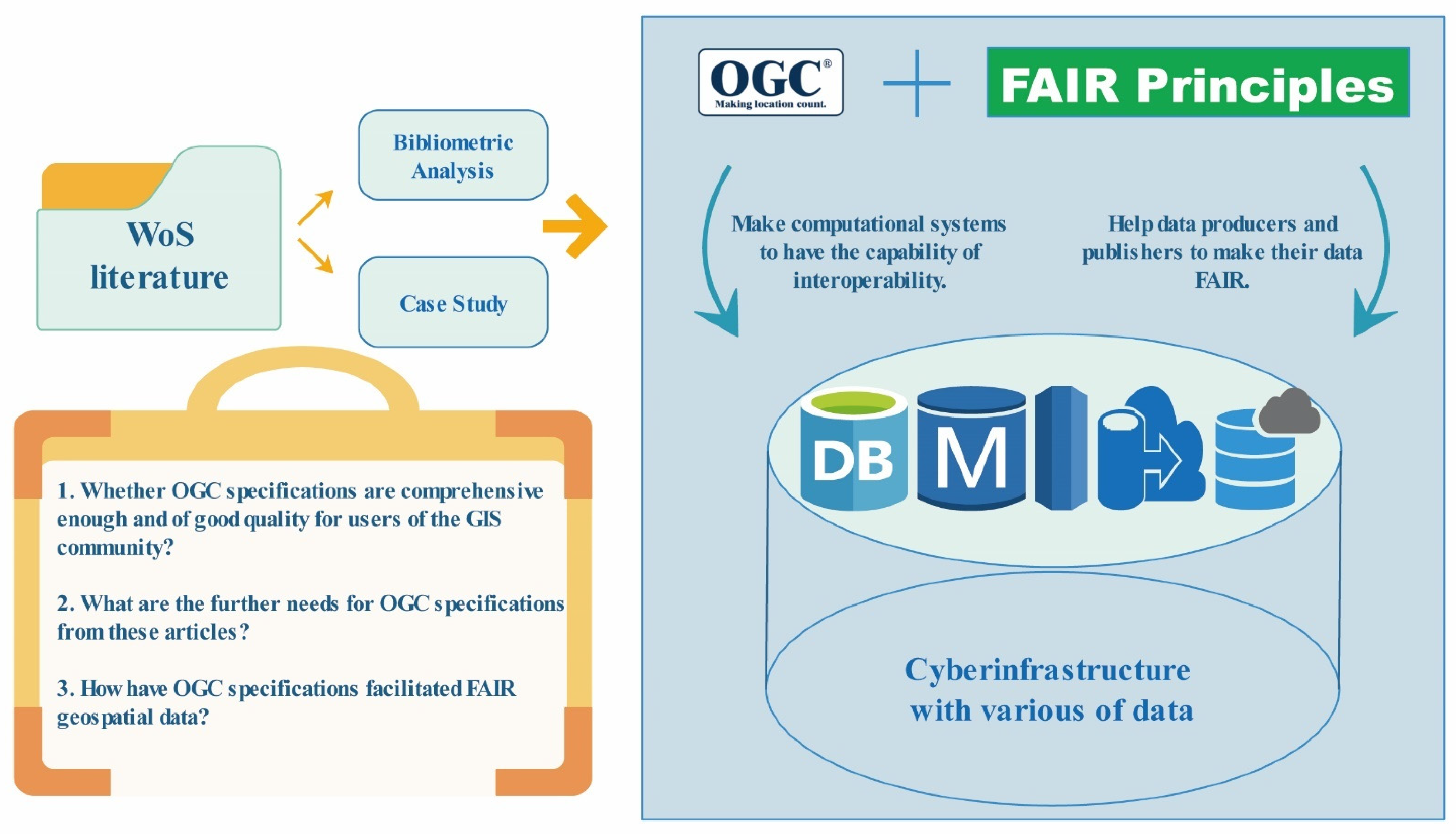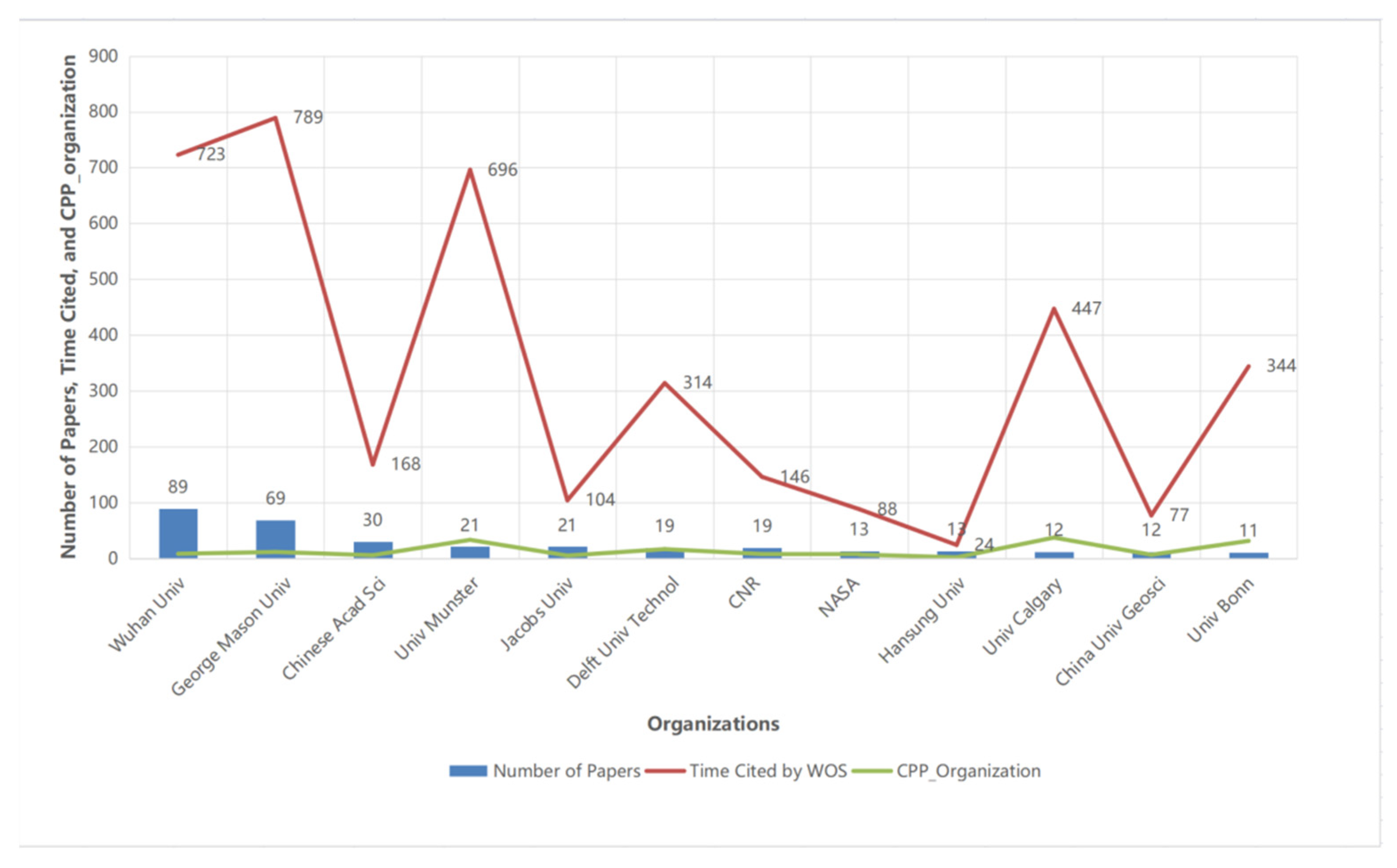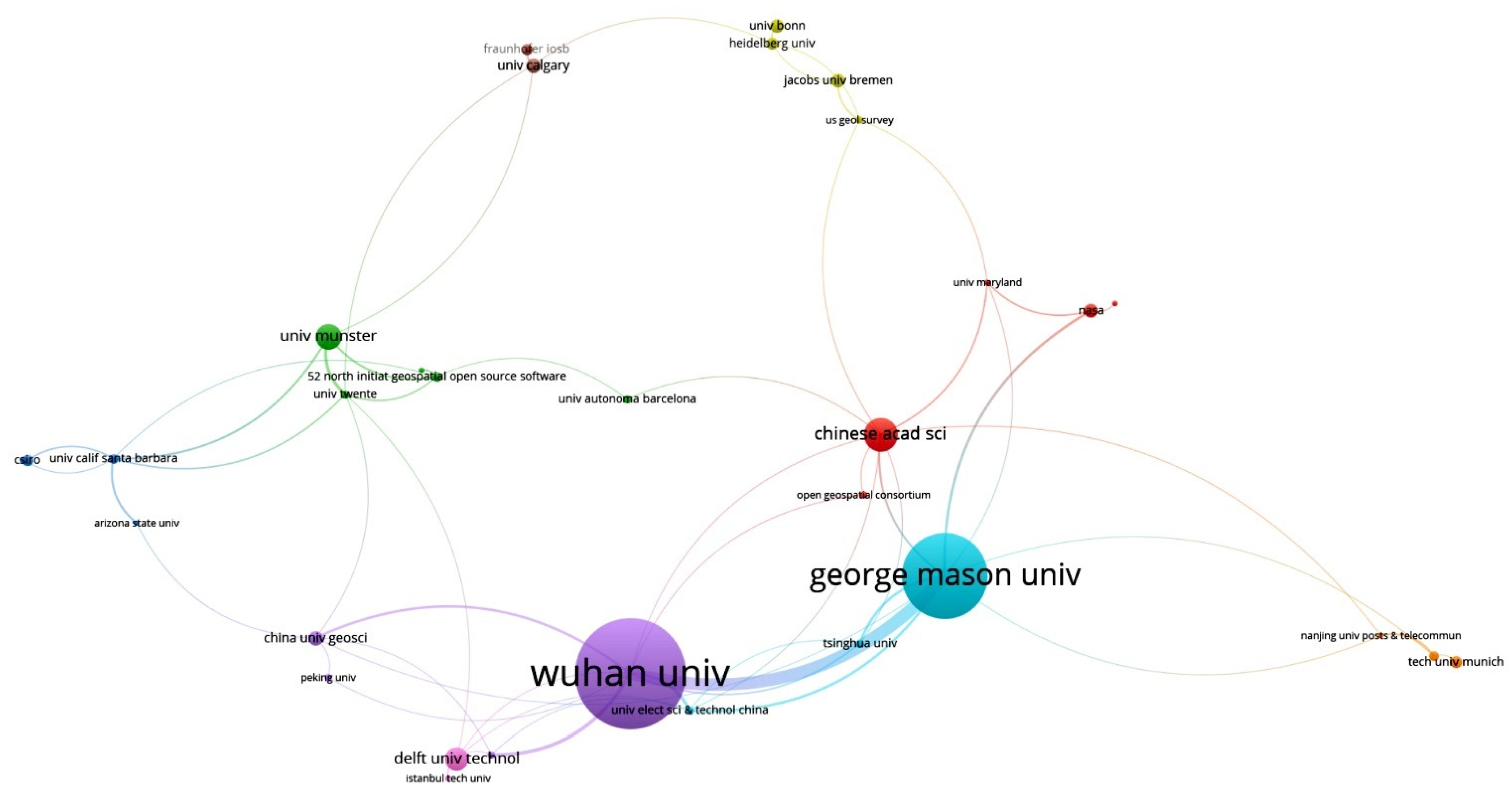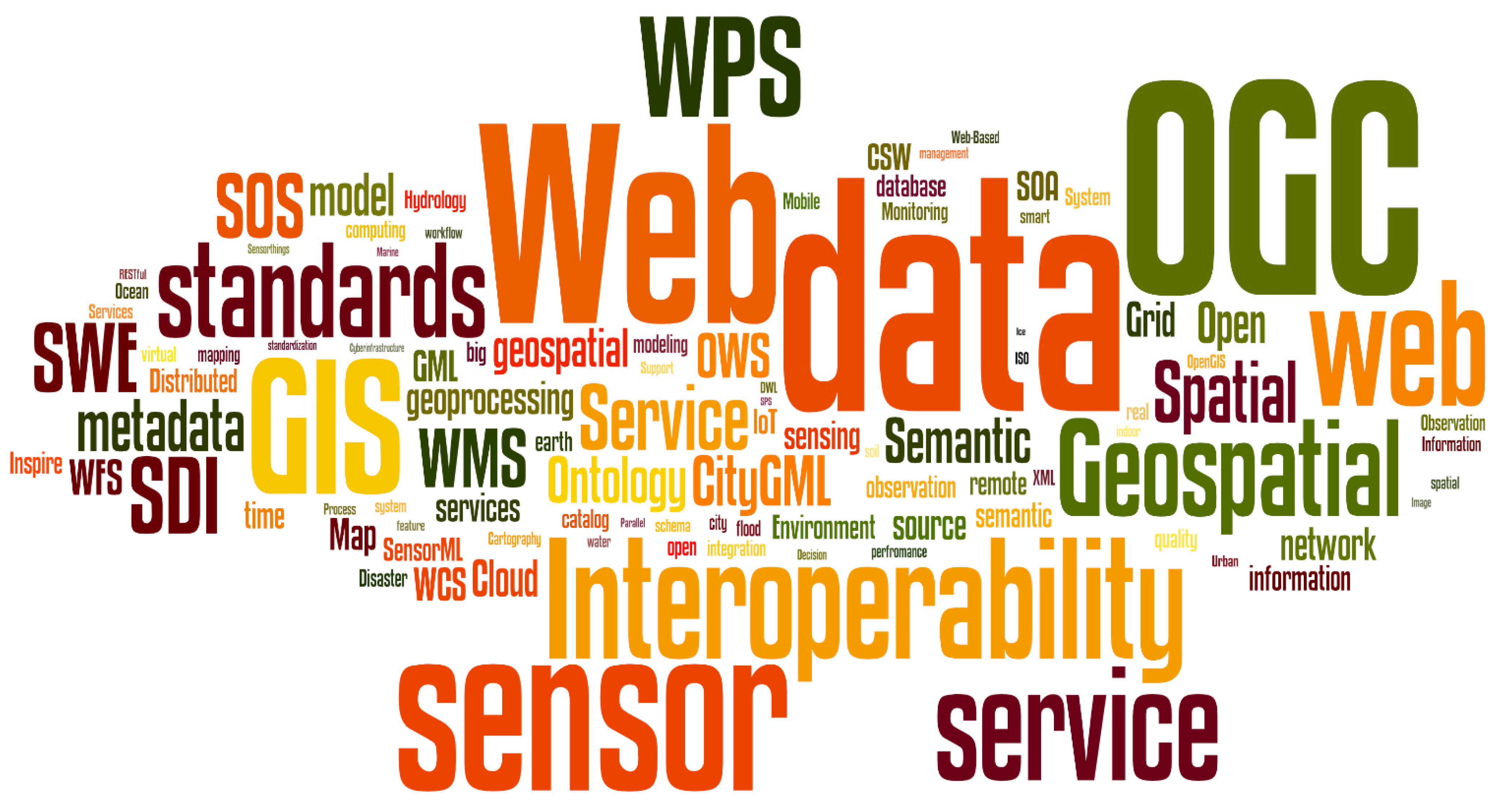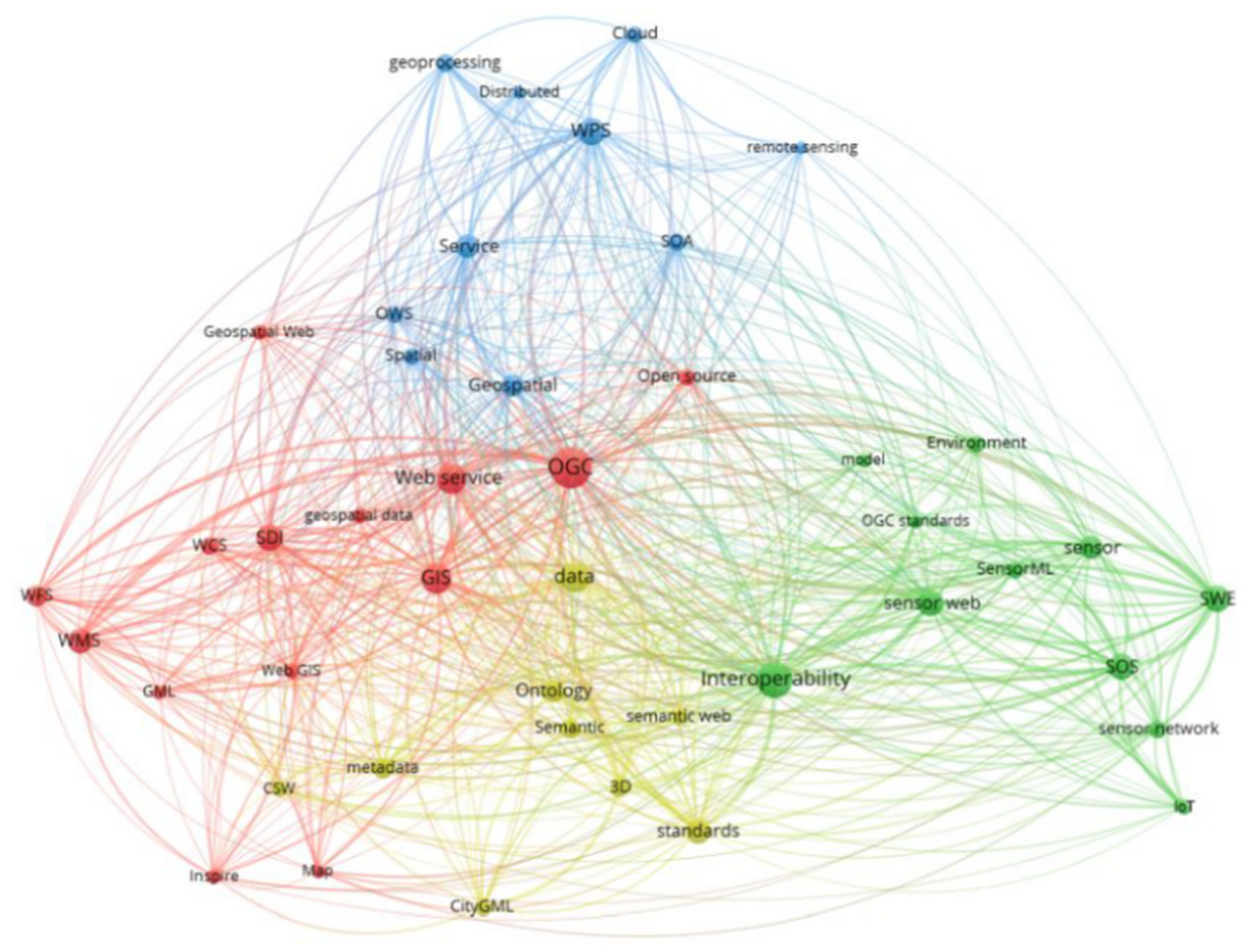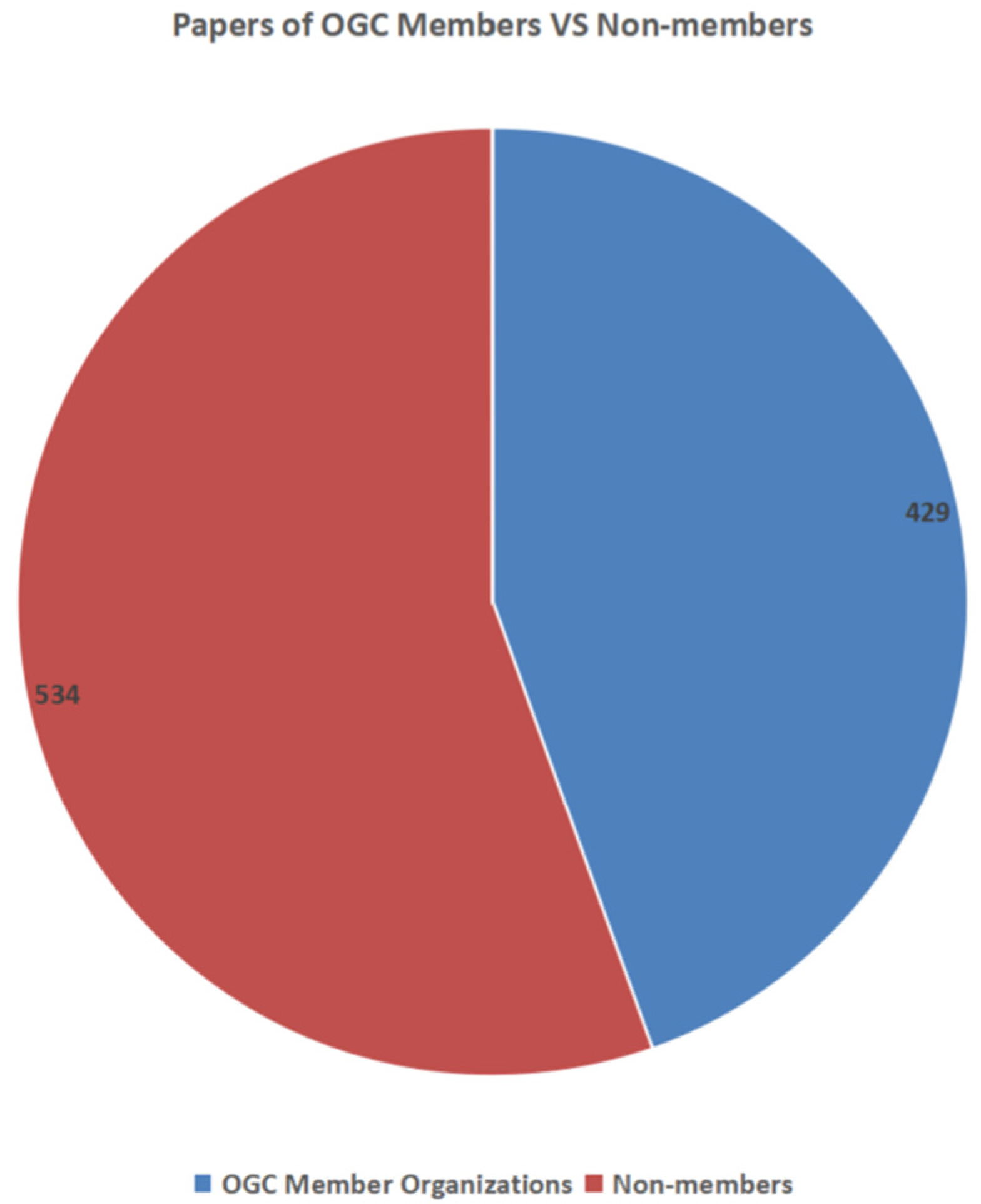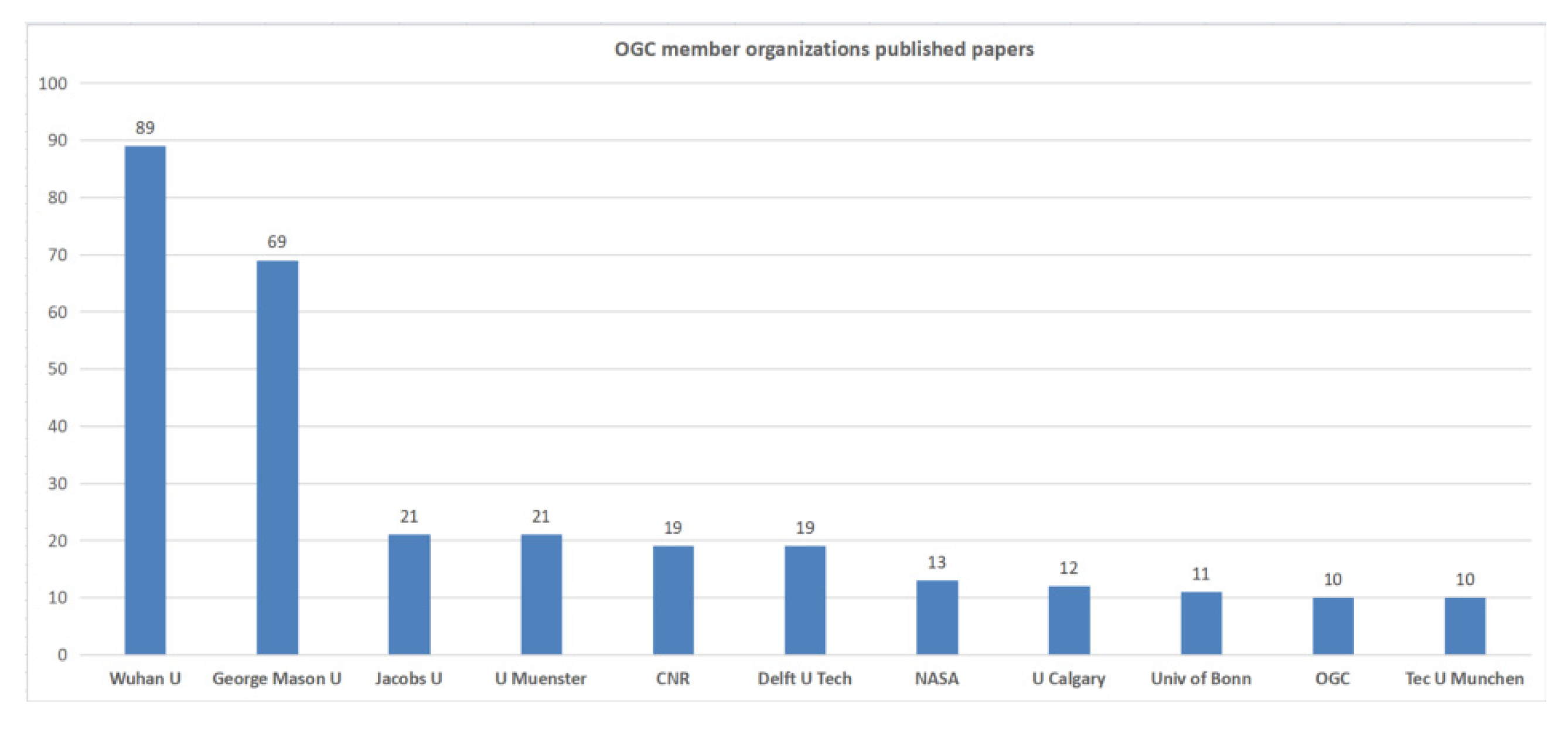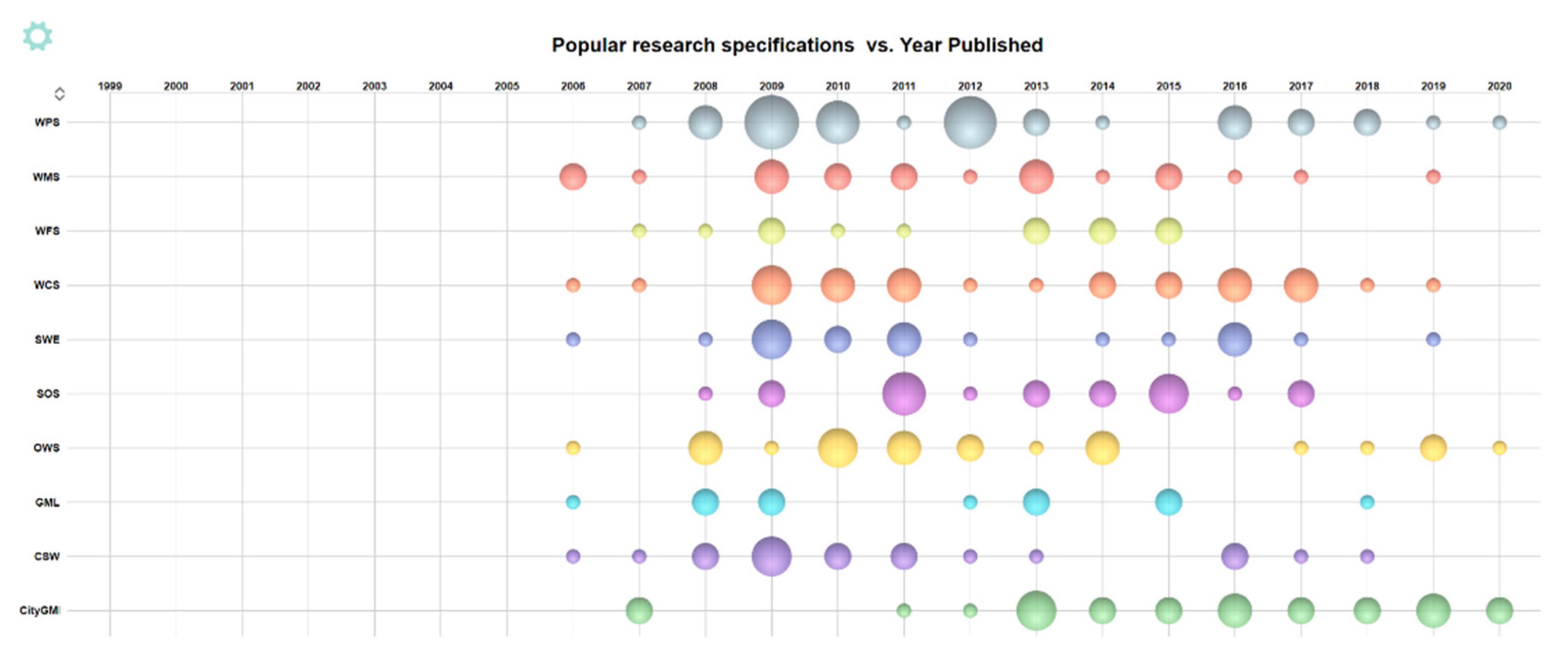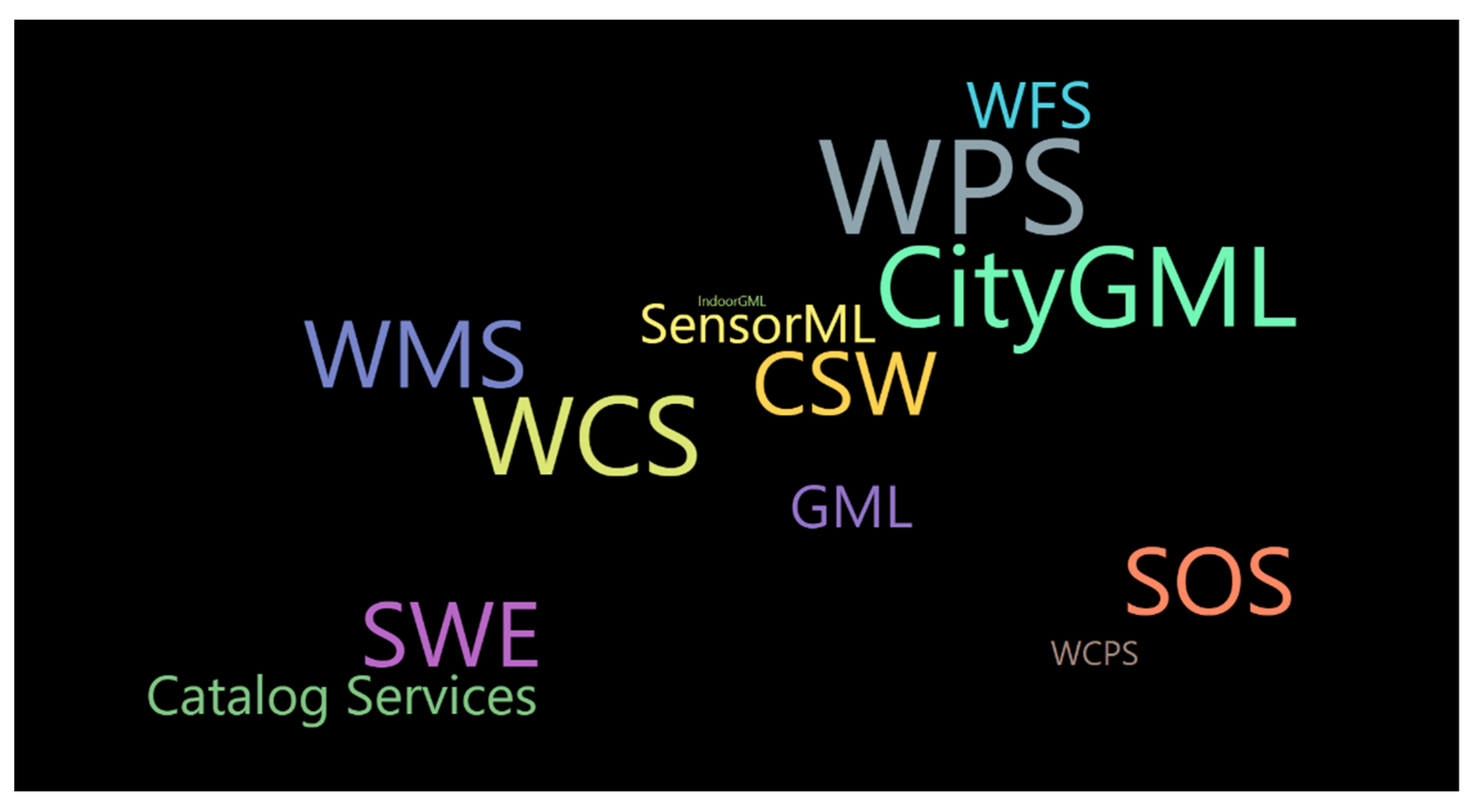3.2. Major Countries and Regions
Figure 5 shows the major countries and regions that published 10 or more papers on the OGC specification. The top five productive countries were the USA with 202 papers, China with 195, Germany with 170, Italy with 83, and Spain with 70, totaling 614 published papers, which is 63.75% of the total.
According to the OGC specification bibliometric profile, 59 main countries and regions were found in which research was conducted and applied. The OGC specifications have continuously been researched in many countries or regions, which greatly facilitates the use of interoperable technologies in data and service sharing. Some papers were collaborated on by authors from many countries. For example, one study with the authors from the United Kingdom, United States, China, Germany, Ireland, and Canada reviewed how Sensor Web, Citizen Sensing, and “human-in-the-loop sensing” enabled decision-makers to use real-time crowdsourced data in public health and emergencies in the Mobile and Social Web era through the OGC SWE and Open GeoSMS [
4]. A study by the authors from China and the USA described a service-oriented multi-purpose SOS framework for creating a single method of access to the heterogeneity of sensor data through OGC CSW, Transactional Web Feature Service (WFS-T), and Transactional Web Coverage Service (WCS-T) [
21].
In the paper profile, about 860 organizations took part in studying the OGC specifications, among which Wuhan University published 88 papers, and George Mason University published 69. Twelve organizations were selected because they each produced more than ten papers, accounting for 34% of total papers and 23% of total citations.
Figure 6 showed the NP, TC, and CPP of the organizations in the WoS, sorted by NP in reverse order.
Wuhan University and George Mason University created a semantics-enhanced geospatial catalog service for solving the inadequacy of discovering geospatial information in Cyberinfrastructure based on the OGC Registry Information Model (ebRIM) of a geospatial catalog service [
22]. Beijing Transportation Information Center and the Chinese Academy of Sciences introduced a Distributed Virtual Geographic Environment (DVGE) system for an Internet-based virtual 2D and 3D environment for sharing geospatial programs, data, and software. The architecture and working mechanisms were developed based on the specifications of grid services, Open Geodata Interoperability Specifications (OpenGIS), and GML [
23].
We conduct a co-authorship cluster analysis on the organizations that published five or more with VosViewer to show the collaborative relationships among the organizations.
Figure 7 shows the result of the cluster analysis of co-authorship organizations, some of the 48 organizations were not connected to each other so they were not shown.
3.3. Core Journals
In the 963-publication OGC bibliometric profile, 478 publications were in Journals, Series Conferences, and Books. Based on Bradford’s law of paper scattering, a small number of “core journals” carry a large number of papers. To identify the core journals, we used Bradford’s law to do an evidence-based analysis of the publications. Developed in 1934, Bradford’s law describes that scientific publications can be arranged in order of descending productivity of papers on a given subject and divided into three zones containing the same number of papers, with a first zone of “core journals” with the least number of journals that carry the most efficient number of papers, a second zone of “relative journals” with more publications yet the same number of papers as the first zone, and a third zone of “edge journals” with the greatest number of publications. The number of publications from the three zones will follow a 1:
n:
n2 rule, where “
n” is a multiplier [
24].
We arranged the paper count of each publication by descending order as shown in column B of
Table 1. Columns C, D, and E showed that the papers were divided into three zones, which contained almost the same number of papers, i.e., 312:307:344. Column F shows the count of publications in three zones, i.e., 23:111:344.
According to Bradford’s Law, the number of publications from the three zones follows the relationship 1:
n:
n2, then, if
n = 4,
The result matched Bradford’s Law. The 23 publications were the core journals of OGC specification research in WoS. The core journals we found are shown in
Table 2, and each of the core journals published more than seven papers.
In
Table 3, The IEEE International Geoscience And Remote Sensing Symposium (IGARSS) was the most productive source for OGC specification research, in which 51 papers were published, cited 83 times. The CPP of IGARSS was 1.63 times. IGARSS has become an important platform for OGC specification researchers. The two most cited papers were about XML and CSW in IGARSS. An open web GIS service system based on the web GIS architecture of OGC was introduced and implemented, through which interoperability, open environment, and spatial data transfer format could be provided based on XML [
25]. A semantic search was enabled in Catalogue Service for the Web (CSW) by extending OGC ebRIM elements based on the semantic relationship defined in OWL/OWL-S [
26]. For comprehensive access and collaborative planning or controlling the available remote sensor information in a time-critical disaster emergency, the SensorModel V1.0 prototype was designed and implemented based on the OGC SWE Initiative in 2011 [
27] in IGARSS.
From the TC view, Computers & Geosciences was the most cited journal in this analysis, in which 31 papers were cited 613 times, making it the highest CPP_journal up to 19.77 times, accounting for 9% of the total of 6818 citations. The most cited paper in Computers & Geosciences was about a heavy need for common markup language for exchanging generic geoscience information in 2005 and the authors developed an approach based on the OGC Geography Markup Language (GML) to share geoscientific information of boreholes, text, and structural geology [
28]. The second most cited paper was about OGC Sensor Observation Service (SOS) and Web Feature Service (WFS) in the journal. SOS and WFS were used to develop an approach for supporting flood risk management by combining information provided by Wireless Sensor Networks (WSN) and Volunteered Geographic Information (VGI), which confirmed that interoperable specifications could support the integration of heterogeneous data [
29].
Table 3 shows NP, TC, and CPP_journal in reverse order. Only those publications with more than 50 TC were selected.
3.4. Research Fields
OGC specifications have been used in numerous fields and gained significant popularity in recent years. In this study, it was found that OGC specifications were referenced in 80 WoS Categories (WC). The most productive research fields were Remote Sensing, Computer Science Information Systems, and Geography Physical. Among the total literature, the eight most productive research fields covered over 100 papers, selected in
Table 4.
From
Table 4, the WC of Remote Sensing wins the most literature published and the most cited field by peers. For example, Groger, G. and Plumer, L. [
3] reviewed that OGC CityGML was used to exchange 3D city models from its underlying concepts, Levels-of-Detail, and applications to the development trends in the future. The attributes of CityGML such as semantic aspects of 3D city models, structures, taxonomies, and aggregations were contrasted with purely geometric or graphic models such as KML, VRML, or X3D, which did not provide sufficient semantics.
According to the CPP_WC, ‘Computer Science, Interdisciplinary Applications’ was the highest at 11.03. In this field, Vitolo, C. et al. [
5] reviewed available implementations based on web-based technologies to process large and heterogeneous datasets at that time. The implementations based on the OGC specifications with more versatile frameworks that particularly facilitate working together with larger, more heterogeneous data sources.
3.5. Research Keywords
The 2305 unduplicated keywords were manually filtered from the 4590 Author Keywords using DDA. These raw keywords were classified by the same meaning but in different spellings and sorted in descending order of the occurrence times. Two examples of uniformized keywords of ‘OGC’ and ‘WPS’ are shown in
Table 5.
The uniform keywords were visualized by a word cloud analysis method. As shown in
Figure 8, the keywords OGC, Web, Data, Interoperability, GIS, and sensor appeared more frequently, so their sizes are lager than others. The second most frequent keywords were service, standards, and some OGC specification names such as WPS, WMS, WFS, WCS, CityGML, OWS, SWE, SOS, SDI, GML, etc. The word cloud in
Figure 8 shows that OGC specifications are adequate and do meet some needs for the GIS community as a “glue” by interoperating data, sensors, SDI, services, the Web, and users through the WPS, WMS, SOS, SWE, CityML, and other specifications.
Forty-four cleaned keywords appeared over 20 times for a total of 1989 occurrences, accounting for 47.33% of the total keywords. We conducted a co-occurrence cluster analysis on these 44 keywords with VosViewer, a visualization analysis tool. Co-occurrence keyword analysis is a method for analyzing the common presence and frequency of occurrence of keywords in the same paper to find the cluster of research topics.
Table 6 shows the 44 cleaned keywords, and
Figure 9 shows the result of the cluster analysis of co-occurrence keywords.
As shown in
Figure 9, the diameter of a node represents the number of occurrences of the keywords. The bigger the node is, the more times the keywords occur. The line between two nodes indicates that the two keywords appear in the same article. The thicker the line is, the more times the two keywords appear together in the same article. The color of the nodes and the lines represent the different clusters we obtained. Four main clusters, OGC, WPS, Interoperability, and data, were formed. Four different color lines link their own cluster family separately.
In these four main clusters, the cluster of OGC with pink nodes and lines includes Web service, GIS, SDI (Spatial Data Infrastructure), WCS, WMS, WFS, GML, Web GIS, Geospatial Web, and Open source. The cluster of OGC focused mainly on the GIS environment, web services, and infrastructure.
The cluster of WPS with blue nodes and lines includes Service, metadata, OWS, Service-oriented architecture (SOA), Geospatial, Spatial, Cloud, geoprocessing, remote sensing, and distributed. The cluster of WPS focused mainly on the keywords of geospatial service processing.
The cluster of Interoperability with green nodes and lines includes SOS, SWE, sensor, SensorML, sensor web, sensor network, Internet of Things, OGC standards, model, environment, and so on. The cluster of Interoperability focused mainly on the topic of sensors and their web, working environment, and observation services.
The cluster of data with the yellow nodes and lines includes Ontology, Semantic, semantic web, 3D, standards, metadata, CSW, and CityGML. The cluster of data mainly focused on preparing data semantically and standardizing it.
The clusters presented in
Figure 9 are similar to those presented in the OGC specification architecture in
Figure 1. For example, in
Figure 9, the cluster of Interoperability in green includes SWE, SOS, and sensor web as shown in the “sensor” level at the bottom of
Figure 1. This fully demonstrates that the specifications mentioned in the WoS papers are consistent with the purpose of the OGC, that is, the quality is good.
3.7. OGC Membership Analysis
We carried out a set of OGC membership analyses to disclose which, when, how many, and by whom the OGC specifications were advanced and studied from 963 papers in our dataset. The first analysis is a comparison between the OGC members and non-members. By combining different spellings, we acquired 855 organizations from the Author’s Address (Organization only) fields that had 1742 organizations initially. We obtained 510 member organizations from the OGC website. We matched the two groups of organizations then found that members contributed almost half of the papers, as shown in
Figure 10.
In the OGC membership group, we chose the organizations that published ten or more. Wuhan University and George Mason University published a total of 129 papers, which accounted for 30% of member contributions, shown in
Figure 11.
As mentioned earlier, the OGC standards have been extensively studied. Some were studied early and some were developed later in our study period.
Figure 12 shows the age and number of high-profile OGC specifications. WMS, WCS, SWE, GML, and CSW emerged in 2006. WPS was highly focused between 2009 to 2012, while CityGML turn into a popular research topic sharply in 2013.
Among OGC specifications, some were studied or introduced by papers alone, though most came together.
Figure 13 shows the connections among their co-occurrence. WCS, which was studied by 26 papers, had the most connections with other specifications. Sensor Web, OWS, and SOS also had very high frequency and was studied with others together.
We chose the high frequency studied specifications from the OGC member organization papers and conduct a word cloud analysis with published 7 or more.
Figure 14 shows the most popular research in a black background to distinguish the all dataset word analysis in
Figure 8.

